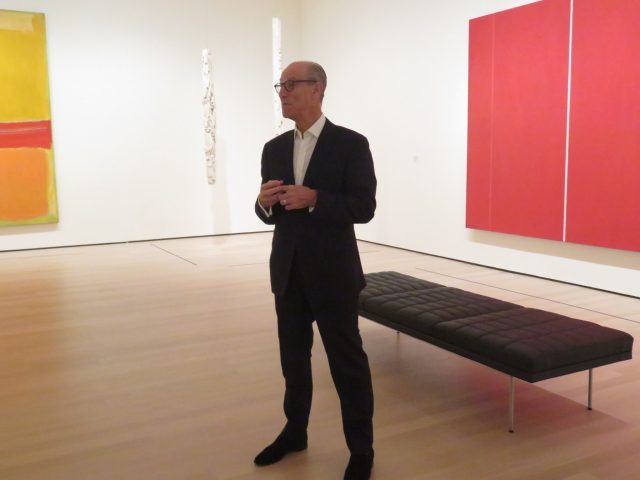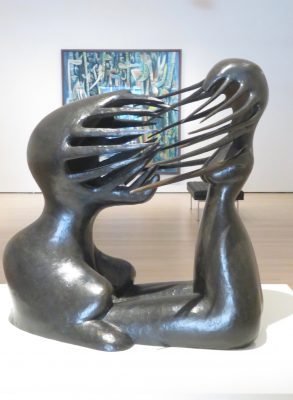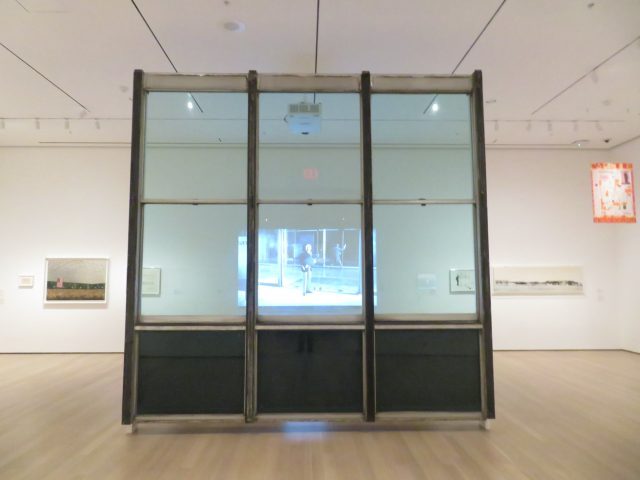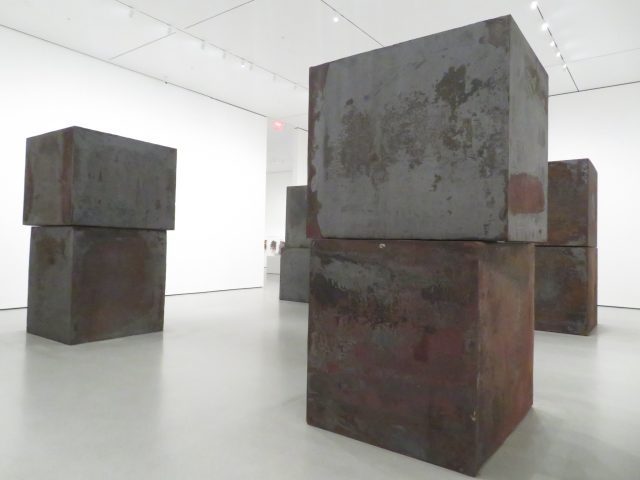
MoMA director Glenn D. Lowry shows off museum’s ambitious new approach (photo by twi-ny/mdr)
MoMA, Museum of Modern Art
11 West 53rd St. between Fifth & Sixth Aves.
Opens Monday, October 21, $14-$25 (sixteen and under free)
212-708-9400
www.moma.org
Perhaps no single work of art encapsulates the newly renovated, revamped, and expanded Museum of Modern Art as much as Richard Serra’s 2015 Equal, which gets its own room on the fourth floor. Eight forged weatherproof steel blocks are stacked in pairs, four on four. Despite their title, they are not the same: the random patterns on their sides are not consistent, the light that gleams through gaps in the stacks reveals the blocks are not exact replicas of each other, and they are positioned on different sides. It announces a new MoMA, reopening today with much fanfare after closing on June 16 for four months of reinstallation, a reimagination and reevaluation of how to display items from its ever-growing collection of more than two hundred thousand works. At an intimate press preview, museum director Glenn D. Lowry used all the right words and phrases to bring MoMA into 2019 and beyond, including “a more global perspective,” “pluralism,” “dialogues,” and “diversity.”
He was standing in gallery 404, “Planes of Color,” carefully chosen as representative of the institution’s updated curatorial approach. Instead of being essentially chronological, the room combines painting and sculpture in a more complex way, creating what Lowry said is a “conversation through time and space.” Thus, brought together are an obvious grouping of Russian-born American artist Mark Rothko’s No. 10 and No. 5/No. 22, American artist Ad Reinhardt’s Number 107, and American artist Barnett Newman’s Abraham and Vir Heroicus Sublimis, along with the less-expected choices of Ukraine-born American artist Louise Nevelson’s Hanging Column from Dawn’s Wedding Feast and Indian artist Vasudeo S. Gaitonde’s exquisite Painting, 4. “I hope that my painting has the impact of giving someone, as it did me, the feeling of his own totality, of his own separateness, of his own individuality, and at the same time of his connection to others,” Newman said in a 1965 interview with David Sylvester. “If a meeting of people is meaningful, it affects both their lives.” The same goes for this meeting of artworks.

Maria Martins’s The Impossible, III tears apart conventional ideas of curation (photo by twi-ny/mdr)
In gallery 503, “Around Les Demoiselles d’Avignon,” thirteen works by Pablo Picasso from 1905 to 1912 are joined by Louise Bourgeois’s 1947-53 Quarantania, I sculpture and Faith Ringgold’s 1967 painting American People Series #20: Die 1967, a Guernica-inspired canvas about race, class, and violence. One of the museum’s greatest hits, Les Demoiselles d’Avignon, hangs in a corner, given no special prominence. Similarly, Vincent van Gogh’s The Starry Night and Henri Rousseau’s The Sleeping Gypsy, two other perennial favorites, are side by side on a far wall in gallery 501, along with turn-of-the-twentieth-century earthenware by George Ohr. The works on display will rotate every six months, although the classics will most likely always be on view, but not necessarily in the same place. “My ambition is to get past worrying about the canon,” Lowry said. “We’re shaking it up.”
The Worlds to Come gallery on the second floor was inspired by Jack Whitten’s Atopolis: For Édouard Glissant, an eight-panel acrylic canvas depicting a tattered America as if seen from space; it is accompanied by Trisha Donnelly’s Untitled video, Kara Walker’s ink and pencil on paper Christ’s Entry into Journalism, Michaela Eichwald’s Duns Scotus on artificial leather, Deana Lawson’s pigmented inkjet print Thai, and Nairy Baghramian’s styrofoam, aluminum, and cork Maintainers A, a wide range of disciplines and artists that the wall text puts in context of MoMA’s new curatorial decision-making: “Employing a range of forms and materials, some of these works address historical traumas and their present-day echoes, while others imagine a more hopeful future rooted in multiplicity and diversity. Purposefully open-ended, this grouping of works refuses a tidy summation of the art of our time.”

MoMA mixes artistic disciplines in revamped galleries (photo by twi-ny/mdr)
You can find the unexpected everywhere. An excerpt from Jacques Tati’s 1967 comedy Playtime can be viewed in gallery 417 through a piece of the facade from the 1952 UN Secretariat Building in a space dedicated to architecture. Alma Woodsey Thomas’s Fiery Sunset is in a gallery otherwise filled with paintings and sculptures by Henri Matisse. (Matisse’s The Swimming Pool gets its own room, as do Rosemarie Trockel’s Book Drafts and Joan Jonas’s Mirage.) The “Picturing America” gallery includes photographs by Dorothea Lange, Aaron Siskind, Rudy Burckhardt, Edward Weston, Walker Evans, and others alongside paintings by Edward Hopper, another example of the cross disciplines MoMA is now emphasizing.
Visitors to the second-floor contemporary galleries are greeted by Dara Birnbaum’s Technology/Transformation: Wonder Woman video, complete with explosion; to the right are two dozen of Cindy Sherman’s Untitled Film Stills, while to the left is Louise Lawler’s Does Andy Warhol Make You Cry?, a photo of Andy Warhol’s Gold Marilyn Monroe from a 1988 Christie’s auction. It’s a bold, if cheeky, way for MoMA to exclaim its dedication to women artists, blowing up the past.

Richard Serra’s 2015 Equal gets its own room in new MoMA (photo by twi-ny/mdr)
Among what’s new are the Paula and James Crown Creativity Lab, where adults can learn about process and create their own art (kids can still drop in at the Samuel and Ronnie Heyman Family Art Lab in the Education and Research Building), and the fourth-floor Marie-Josée and Henry Kravis Studio, which will host live and experimental programming beginning with David Tudor’s immersive audio installation Rainforest V (variation 1); Tudor’s Forest Speech will be performed in the space October 24, 26, and 27 ($10-$15, 8:00) by Phil Edelstein, Marina Rosenfeld, Stefan Tcherepnin, Spencer Topel, and Jeremy Toussaint-Baptiste as well as three days each in November and December by different sets of musicians.
The museum’s initial exhibitions are all culled from the collection, furthering MoMA’s goal of making more of it available to the public: “Taking a Thread for a Walk,” “The Shape of Shape Artist’s Choice: Amy Sillman,” “Energy,” “Projects 110: Michael Armitage,” “Haegue Yang: Handles” (which will be activated daily at 4:00), “Private Lives Public Spaces” (home movies from dozens of artists and filmmakers), “Surrounds 11: Installations,” “Sur moderno: Journeys of Abstraction ― The Patricia Phelps de Cisneros Gift,” “member: Pope.L, 1978–2001,” and “Betye Saar: The Legends of Black Girl’s Window.” Philippe Parreno’s immersive, site-specific Echo provides sound, light, and movement in the entries on both West Fifty-Third and Fifty-Fourth St., yet more evidence that art is everywhere, in this case putting the visitor at the very center. “It is nearly impossible to make people understand each other,” explained Maria Martins, whose spiky 1946 bronze sculpture The Impossible, III greets people in gallery 401, the theme of which is “Out of War.” With its focus on diversity, juxtapositional dialogues, rotating works, and reconsidered approach to curation, MoMA is trying to get people to understand art, and each other, a whole lot better, in ways that make sense in our current era.